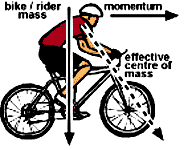|
Even if you've got an old clunker - you'll weigh considerably more than it does. A typical rider to bike weight ratio is around 6:1. The obvious implication is that the position of your body on the bike has a major effect on how the whole arrangement performs. Weight transfer is the secret to controlled descent and stopping.
Stopping Gracefully
On the previous page we talked about setting up your brakes correctly for one (or at the most two) finger braking. The secret to stopping in a hurry is to focus on your front wheel. On the flat, it accounts for about 70% of your stopping power - even more when you're on the slope! When you hit the brakes, your effective centre of mass moves forward - the back wheel lifts and the front digs in. So there's more traction up front and more effective stopping using the front brake. It's a good plan to shift your weight back at the same time to avoid pitching over the handle bars.
Warning: ensure the bike is upright and pointing straight ahead while braking heavily, ie. not cornering. Remember to squeeze the brakes progressively rather than "slamming on the anchors." You achieve maximum braking just before your wheels lock up (same principle as ABS on cars). Skidding is not an effective way to stop, is totally uncool for the track and shows your lack of skill to others.
Downhill braking
As you descend, your centre of mass shifts forward causing the back wheel to become unweighted. When you brake, your effective centre of mass moves even further forward and the stopping process wants to rotate you and your bike over the front wheel. Clearly this is not a good scene. Compensate by keeping your body low and easing your bum off the back of the seat.
When it's really steep you'll end up with your stomach resting on the saddle. You've got it right when your back wheel stays in contact with terra firma, so the bike is stable and you avoid doing the full frontal spontaneous dismount (ouch).
|